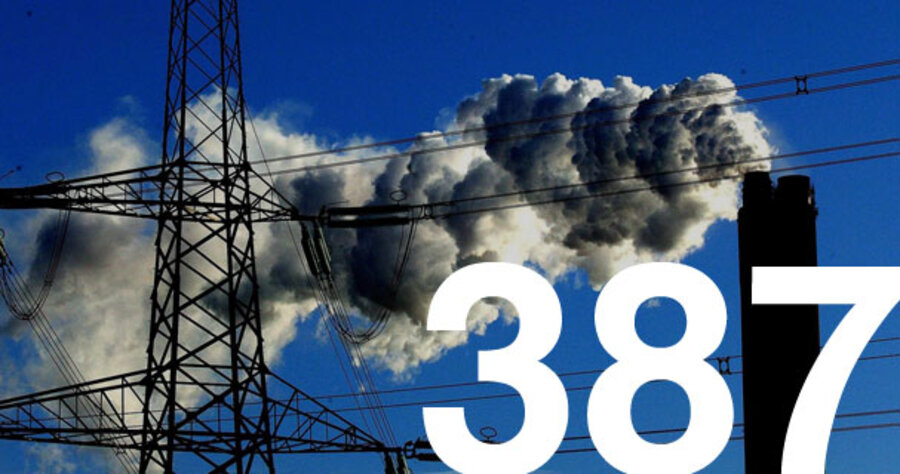Today's number: 387
Loading...
Atmospheric carbon dioxide levels now stand at 387 parts per million.
[Source: The Guardian]
That's almost 40 percent higher than they were at the beginning of the Industrial Revolution, and the highest they've been for at least the past 650,000 years.
And it's also apparently 37 ppm too high. In a paper published last month, NASA's chief climatologist, James Hansen, noted that our atmosphere's current levels of carbon dioxide spell catastrophe for the planet and its inhabitants. "If humanity wishes to preserve a planet similar to that on which civilization developed and to which life on Earth is adapted," he wrote, "paleoclimate evidence and ongoing climate change suggest that CO2 will need to be reduced from its current 385 ppm to at most 350 ppm."
If we fail to achieve these reductions, say Hansen and his colleagues, we run the risk of reaching a tipping point at which climate change becomes irreversible.
According to the paper, we can bring these levels back down by phasing out all coal emissions by 2030. That will keep peak CO2 at 400 ppm. We can reduce it by another 50, says Hansen, through reforestation.
What you can do
This is the big one. Reducing carbon dioxide emissions is humanity's greatest environmental challenge, and possibly humanity's greatest challenge, period. You probably already know many of the myriad steps that you can take to reduce your personal carbon footprint (if not, you can start by calculating your footprint it here). But beating climate change is going to take more than just individual lifestyle changes. We'll need to change the way our civilization is designed. That means putting the pressure on industry and on your representatives in government – some of whom will be traveling to Copenhagen at the end of next year to negotiate a post-Kyoto climate framework – by employing petitions, marches, rallies, ad campaigns, boycotts, strikes, civil disobedience, whatever it takes to save the planet.
Project 350 seeks to coordinate actions, such as art, music, and political demonstrations, into an international campaign to inform people of the scale of our climate crisis. Writing in a widely syndicated op-ed, the project's founder, writer Bill McKibben, says 350 "may be the most important number on Earth." He wrote:
We do have one thing going for us – the Web – which at least allows you to imagine something like a grass-roots global effort. If the Internet was built for anything, it was built for sharing this number, for making people understand that "350" stands for a kind of safety, a kind of possibility, a kind of future.
Hansen's words were well-chosen: "a planet similar to that on which civilization developed." People will doubtless survive on a non-350 planet, but those who do will be so preoccupied, coping with the endless unintended consequences of an overheated planet, that civilization may not.
Civilization is what grows up in the margins of leisure and security provided by a workable relationship with the natural world. That margin won't exist, at least not for long, as long as we remain on the wrong side of 350. That's the limit we face.
Looking ahead
"Stabilizing atmospheric CO2 and climate," writes Hansen, "requires that net CO2 emissions approach zero, because of the long lifetime of CO2."
Hansen is not alone in pushing for zero carbon. In March, the Washington Post reported that two separate studies appeared within weeks of one another, each suggesting that we must get off fossil fuels by midcentury in order to avoid catastrophic climate change.
One city on the outskirts of Abu Dhabi in the United Arab Emirates is seeking to do just that. Announced on May 5 at MIT, the Masdar Initiative seeks to build a completely sustainable city, with zero carbon emissions and zero waste. Designed by the British architectural firm Foster + Partners, the city will be powered by solar, wind, and burning composted food waste. According to the New Scientist magazine, cars will be banned within the city limits. Instead, the city's 50,000 residents will travel by light rail and by "personal rapid transport pods" powered by the city's solar panels.
Creating something like Masdar City on a global scale will be a mammoth task. It will make the postwar Marshall Plan look like a two-car parade. But the alternative is a planet that is mostly uninhabitable. I, for one, am looking forward to riding in my personal transport pod.





